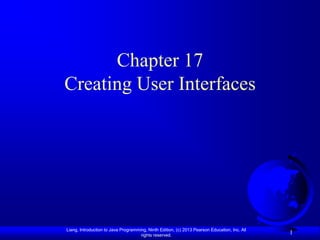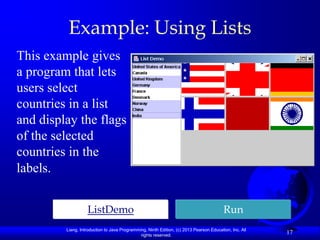This chapter discusses creating graphical user interfaces (GUIs) in Java by introducing commonly used GUI components like JTextArea, JComboBox, JList, JScrollBar, and JSlider and providing examples of how to use each component to build user interfaces. It also covers creating multiple windows in an application by extending JFrame to create additional window subclasses and instantiating those subclasses.









![JComboBox
A combo box is a simple list of items from which the user can
choose. It performs basically the same function as a list, but
can get only one value.
javax.swing.JComponent
javax.swing.JComboBox
+JComboBox() Creates a default empty combo box.
+JComboBox(items: Object[]) Creates a combo box that contains the elements in the specified array.
+addItem(item: Object): void Adds an item to the combo box.
+getItemAt(index: int): Object Returns the item at the specified index.
+getItemCount(): int Returns the number of items in the combo box.
+getSelectedIndex(): int Returns the index of the selected item.
+setSelectedIndex(index: int): void Sets the selected index in the combo box.
+getSelectedItem(): Object Returns the selected item.
+setSelectedItem(item: Object): void Sets the selected item in the combo box.
+removeItem(anObject: Object): void Removes an item from the item list.
+removeItemAt(anIndex: int): void Removes the item at the specified index in the combo box.
+removeAllItems(): void Removes all items in the combo box.
Liang, Introduction to Java Programming, Ninth Edition, (c) 2013 Pearson Education, Inc. All
rights reserved.
10](https://image.slidesharecdn.com/17slide-120813172731-phpapp01/85/JavaYDL17-10-320.jpg)



![JList
A list is a component that performs basically the same function as a combo
box, but it enables the user to choose a single value or multiple values.
javax.swing.JComponent
javax.swing.JList
+JList() Creates a default empty list.
+JList(items: Object[]) Creates a list that contains the elements in the specified array.
+getSelectedIndex(): int Returns the index of the first selected item.
+setSelectedIndex(index: int): void Selects the cell at the specified index.
+getSelectedIndices(): int[] Returns an array of all of the selected indices in increasing order.
+setSelectedIndices(indices: int[]): void Selects the cells at the specified indices.
+getSelectedValue(): Object Returns the first selected item in the list.
+getSelectedValues(): Object[] Returns an array of the values for the selected cells in increasing index order.
+getVisibleRowCount(): int Returns the number of visible rows displayed without a scrollbar. (default: 8)
+setVisibleRowCount(count: int): void Sets the preferred number of visible rows displayed without a scrollbar.
+getSelectionBackground(): Color Returns the background color of the selected cells.
+setSelectionBackground(c: Color): void Sets the background color of the selected cells.
+getSelectionForeground(): Color Returns the foreground color of the selected cells.
+setSelectionForeground(c: Color): void Sets the foreground color of the selected cells.
+getSelectionMode(): int Returns the selection mode for the list.
+setSelectionMode(selectionMode: int): Sets the selection mode for the list.
Liang, Introduction to Java Programming, Ninth Edition, (c) 2013 Pearson Education, Inc. All
rights reserved.
14](https://image.slidesharecdn.com/17slide-120813172731-phpapp01/85/JavaYDL17-14-320.jpg)
![JList Constructors
JList()
Creates an empty list.
JList(Object[] stringItems)
Creates a new list initialized with items.
Liang, Introduction to Java Programming, Ninth Edition, (c) 2013 Pearson Education, Inc. All
rights reserved.
15](https://image.slidesharecdn.com/17slide-120813172731-phpapp01/85/JavaYDL17-15-320.jpg)













